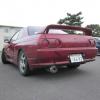R32 Power steering
Announcements
-
Similar Content
-
Latest Posts
-
By Dose Pipe Sutututu · Posted
Just a thought, how come you didn't use a 4D table? So you essentially run 2x fuel and 2x ignition tables, and the table/map switch is handled when there's enough WMI pressure detected. This is mine, but using the flex sensor as the 4th dimension, note the slider at the bottom. Between 0 to 70%, the timing is blended/interpolated , once it goes past 70% ethanol full send -
Hi guys, after dreaming of owning a JDM legend for 20 years, I got the chance to buy a 1995 R33 GTR. I live in a small country called the Solomon Islands which is in the pacific. There is no performance car scene here, however 90% of vehicles here are 2nd hand Japanese imports so there is a handful of JDM sports cars here, tucked away. 3 Evo VI’s, 1 180sx turbo, 2 GTO’s, 1 R32 GTR and 2 R33 GTR’s. Only 1 Evo and a 33 (mine) are active. I’m hoping to set up a club to get these cars back in the road. I’d known of my GTR for 9 years and always dreamed of owning it. At the start of this year I found it sitting outside a workshop waiting for a respray. It was in pretty bad shape, although running and driving perfectly apart from a big exhaust leak and worn out bushings. My brother in law who is a huge GTR guy came over for a holiday and I took him to see it, he got into my ear and I bought the car 2 weeks later as is. I’ve had a pretty bad problem with alcohol and weed since 2020 and I really wanted to quit. So I used this as my motivation. I quit everything cold turkey and have been investing all my spare time into restoring this car. It’s honestly been the best experience and has been such a positive impact on my life. There is no market for these cars here, no parts and no mechanics that can work on them, so if you wanted to sell one it would be pretty impossible unless you found the right buyer. After a bit of negotiating with the previous owner (a good friend) I got the car for $15,000 AUD ($85,000 SBD) which is insane. I’ve almost finished doing a refresh on the engine, new turbos, spark plugs and split fire coil packs. Also new gaskets and seals, This car had no leaks to begin with, but it’s due now being 30 years old. . Next I’ll be working on the suspension, all new bushings, ball joints, king pins and new coil overs. Then it will be body work, it has really bad rust in the boot floor, I have purchased a rear beaver cut from my bro which will replace the rusted out one. The car is originally KL0, but was burnt orange when it landed here, then it was resprayed toxic green and then Bayside Blue. I’m probably going to get it redone in Bayside Blue. I’m super grateful to be able to enjoy this car and couldn’t have done it without my bro Chris from OG-JDM. Looking forward to the future with this car and hoping to get it on the runway at the airport here 😂 cheers fellas
-
Also, it is just about triangularity. The less angle, the easier it physically is to do. Think of the amount of slip you're getting, as how hard you need to push an object. More slip, equals pushing way harder. Then the ramp is how steep the hill is. The Accel is less slip, which means it takes less pushing (less slip) to get it to be able to push apart. However, the steeper sides on the decell means it will take a lot more pushing (slip) to get it up the ramp.
-
It's the angle of the ramp from the vertical. You're measuring from the horizontal. To convert, take 90* minus your angle reference = Nismo Angle.
-
I agree, thus 45 degree is the *max* force one could apply to it. This is similar to what I've seen in uh... simulations... which allow you to play with diff ramp angles. Anything higher (or lower) than 45 degree would produce less force as 45 is the max... triangley. I would state the 1 way is 90 degree, at least this is how my brain and other ways of explaining it refer to it. 90 degree also effectively acted completely open. I realise Nismo refer to it not as 90 (or 89) but "1". So I'm not understanding the angle on which these angles are based.
-







Recommended Posts
Create an account or sign in to comment
You need to be a member in order to leave a comment
Create an account
Sign up for a new account in our community. It's easy!
Register a new accountSign in
Already have an account? Sign in here.
Sign In Now